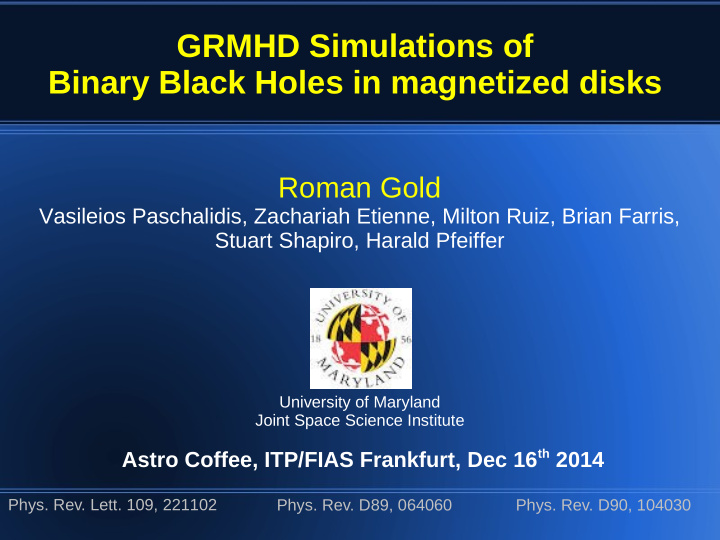



GRMHD Simulations of Binary Black Holes in magnetized disks Roman Gold Vasileios Paschalidis, Zachariah Etienne, Milton Ruiz, Brian Farris, Stuart Shapiro, Harald Pfeiffer University of Maryland Joint Space Science Institute Astro Coffee, ITP/FIAS Frankfurt, Dec 16 th 2014 Phys. Rev. Lett. 109, 221102 Phys. Rev. D89, 064060 Phys. Rev. D90, 104030
Outline Astrophysical context & Motivation BHBH+disks modeling Results, highlights Summary & Outlook
Galaxies merge !
Formation of SMBH binaries Benson 2013 Farris et al 2011 Begelman et al 1980
Astrophysical evidence ● SMBHs grow through accretion & merger ● SMBHs accrete & shine throughout cosmic evolution → SMBH merger with EM counterpart Observational facilities: ● GWs: Pulsar Timing Arrays ~2017, eLISA 2032+ ● EM transients: e.g. PanStarrs, WFIRST, LSST
EM counterparts ● BHBH in vacuum: well understood system ● Now: BHBH in (magnetized) gaseous environments ● Goal: Identify EM counterpart ● Precursor (periodicities, jets, fainting, ...) ● Afterglow (merger aftermath, rebrightening, …) → Need source modeling! Know what to look for!
thin disk THICK disk → Geometrically thin → Geometrically thick → Optically thick (opaque) → Optically thin (transparent) → Cold → Hot → Truncated near BH? → Outflows, Jets, Winds → thermal spectrum → non-thermal spectrum Refs: Narayan & Yi 1994 Refs: Shakura & Sunyaev 1973 Novikov & Thorne 1974
thin disk THICK disk SCALE HEIGHT H Gravitational potential energy Gravitational potential energy Kinetic energy Kinetic energy Heat Heat Outgoing Outgoing Into the BH Into the BH Radiation Radiation
Binary-disk decoupling ● Disc dynamics Pre decoupling determined by interplay between viscous and binary tidal torque INSPIRAL ● Equate disk response (→viscous) time scale Post decoupling with inspiral rate (→GW time scale) ● solve for separation → decoupling radius
Binary-disk decoupling ● Disc dynamics Pre decoupling determined by interplay between viscous and binary tidal torque INSPIRAL ● Equate disk response (→viscous) time scale Post decoupling with inspiral rate (→GW time scale) ● solve for separation → decoupling radius
Magneto-rotational instability (MRI) disk embedded in a weak magnetic ● field is stable to the MRI if and only if: → non-linear outcome is MHD turbulence On average the turbulence acts ● like an effective source of viscosity Viscous torques redistribute ● angular momentum → causes accretion
Length and time scales: Computational Challenge → Adaptive-Mesh-Refinement (AMR)
Previous numerical work ( very abbreviated, see papers) Hydro (B=0): Newtonian (SPH): Artymowicz & Lubow 1994, Cuadra et al 2008, Roedig et al 2011, 2012 MacFadyen et al 2008 GR: Farris et al 2011, Bode et al, Bogdanovic et al Force-free (all in GR): Palenzuela et al 2010 Moesta et al 2010, Alic et al 2012 MHD: Shi 2011 (Newtonian) Noble et al 2012 (Post-Newtonian) Farris et al 2012, Gold et al 2013,2014 (GR)
Modeling of circumbinary disks Artymowicz MacFadyen Shi et al 2011 Noble et al 2012 et al 1994 et al 2008 ` Palenzuela Alic Moesta et al 2012 Farris et al 2012 Gold et al 2014 et al 2010 et al 2012
Methods (I): Numerical Relativity 3+1 split (foliate spacetime) ● Initial data: ● Conformal-Thin-Sandwich Formalism → quasi-equilibrium data → helical Killing vector Predecoupling: ● Analytically rotate CTS metric ID Postdecoupling: ● BSSN formulation “moving punctures” gauge conditions → system is strongly hyperbolic → Vacuum Cauchy Problem is well-posed → Slices penetrate horizons → Singularities at origin can be handled
Methods (II): ideal GRMHD Illinois GRMHD AMR code ● Perfect fluid stress energy tensor ● Eom: Conservation laws (incl. cooling) ● Induction equation for A-field ● Generalized Lorenz gauge condition
Methods III: Generalized Lorenz gauge ● Previously used gauge conditions have zero speed modes ● Lorenz gauge modes propagate at c * ● Generalized Lorenz gauge damps gauge modes to zero * → * Reduce spurious generation of B-field near AMR boundaries ● Crucial for long-term simulations Etienne et al 2012, Paschalidis et al 2012 Farris et al 2012
Method (III): Artificial Cooling ● Realistic cooling depends on detailed microphysics ● Consider two extreme opposite limiting cases (I) no-cooling (II) radiate away all shock generated entropy on a local Keplerian time scale → Bracket real situation by two limiting cases EOS: Ideal Gamma-law
Surface density profiles
RESULTS
Importance of magnetic fields Pure hydro Magnetized → accretion / luminosities underestimated → can't ignore magnetic fields! by orders of magnitude! Gold et al 2013
1:10 (no-cooling) ● Refilling of gap/cavity ● Binary fully emersed in highly magnetized gas ● Densest gas is near the (smaller) horizon Gold et al 2013
predecoupling Just after merger Total view Zoom-in view REU team: Taylor, Kong, Khan, Connelly, Kim, Walsh Gold et al 2014
Outflows Magnetic pressure/ Density (log scale) Density (log scale) → highly magnetized, relativistic outflows Gold et. al. 2014
Transient jet feature around merger AFTER MERGER: Enhanced collimation Increase in magnetic energy in outflows Speed up of outflow Gold et al 2014
Accretion rates / Luminosities Colors: Binary mass-ratio 1:1, 1:2, 1:4 → Mass accretion rates: comparable to single BH case → Cooling luminosity: not sensitive to mass ratio (except 1:1 predecoupling) → EM+KIN Luminosities : Characteristic rises/peaks just after merger L_cool > L_kin > L_EM → GW amplitude: well known chirp Gold et al 2014
Variability ● far from clean (compare to 2D-thin disk studies) ● Not necessarily at binary orbital period ● Highest variability at intermediate mas ratios (confirming d'Orazio, Haiman et al) ● Little variability at larger mass ratios (as expected: → single BH limit)
Conclusions ✔ Predecoupling: Gold et. al. 2013 high accretion rates, dense material remains near horizons, persistent jets ✔ inspiraling and merger: Farris et al 2012 Gold et. al. 2014 Luminosity peaks/rises, enhanced jet collimation ✔ First GRMHD parameter study: Gold et. al. 2013 binary mass ratio, e.g. 1:10 cavity refills →Now: Time for more physics !
The next steps... ✗ Radiative transport (synchrotron, Compton) ...in progress... ✗ Rebrightening (viscous refilling of the hollow) ...in progress... ✗ BH spins ...in progress...
Thank you for your attention! References: arXiv:1410.1543, PRD 90, 10, 104030 arXiv:1312.0600, PRD 89, 6, 064060 arXiv:1207.3354, PRL 109, 221102
Recommend
More recommend